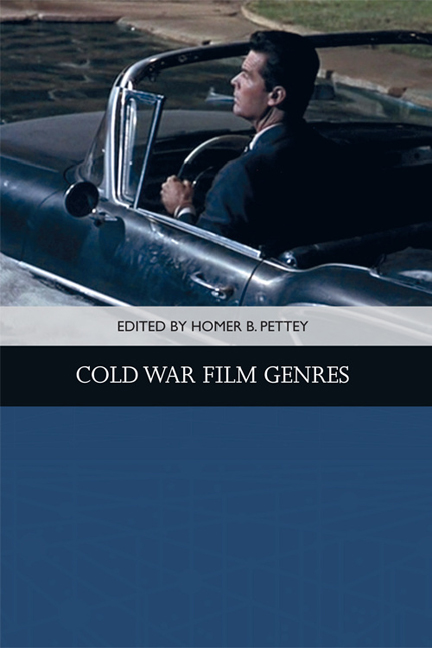Book contents
- Frontmatter
- Contents
- List of Illustrations
- Acknowledgments
- Notes on the Contributors
- 1 Introduction: Cold War Genres and the Rock-and-Roll Film
- 2 Social Factors in Brainwashing Films of the 1950s and 1960s
- 3 The Berlin Crisis? Piffl!: Billy Wilder’s Cold War Comedy, One, Two, Three
- 4 The Small Adult Film: A Prestige Form of Cold War Cinema
- 5 “I’m Lucky – I Had Rich Parents”: Disability and Class in the Postwar Biopic Genre
- 6 Rogue Nation, 1954: History, Class Consciousness, and the “Rogue Cop” Film
- 7 Internal Enmity: Hollywood’s Fragile Home Stories in the 1950s and 1960s
- 8 Suburban Sublime
- 9 Domestic Containment for Whom? Gendered and Racial Variations on Cold War Modernity in the Apartment Plot
- 10 Success and the Single Girl: Urban Romances of Working Women
- 11 Paris Loves Lovers and Americans Loved Paris: Gender, Class, and Modernity in the Postwar Hollywood Musical
- 12 Straight to Baby: Scoring Female Jazz Agency and New Masculinity in Henry Mancini’s Peter Gunn
- Index
11 - Paris Loves Lovers and Americans Loved Paris: Gender, Class, and Modernity in the Postwar Hollywood Musical
Published online by Cambridge University Press: 24 April 2021
- Frontmatter
- Contents
- List of Illustrations
- Acknowledgments
- Notes on the Contributors
- 1 Introduction: Cold War Genres and the Rock-and-Roll Film
- 2 Social Factors in Brainwashing Films of the 1950s and 1960s
- 3 The Berlin Crisis? Piffl!: Billy Wilder’s Cold War Comedy, One, Two, Three
- 4 The Small Adult Film: A Prestige Form of Cold War Cinema
- 5 “I’m Lucky – I Had Rich Parents”: Disability and Class in the Postwar Biopic Genre
- 6 Rogue Nation, 1954: History, Class Consciousness, and the “Rogue Cop” Film
- 7 Internal Enmity: Hollywood’s Fragile Home Stories in the 1950s and 1960s
- 8 Suburban Sublime
- 9 Domestic Containment for Whom? Gendered and Racial Variations on Cold War Modernity in the Apartment Plot
- 10 Success and the Single Girl: Urban Romances of Working Women
- 11 Paris Loves Lovers and Americans Loved Paris: Gender, Class, and Modernity in the Postwar Hollywood Musical
- 12 Straight to Baby: Scoring Female Jazz Agency and New Masculinity in Henry Mancini’s Peter Gunn
- Index
Summary
The popular and critical success of An American in Paris (1951, MGM, directed by Vincente Minnelli) inspired a number of Hollywood musicals that took their American characters to the City of Light. This cycle of 1950s musicals includes Lovely to Look At (1952, MGM, directed by Mervyn LeRoy), April in Paris (1952, Warner Bros., directed by David Butler), Gentlemen Prefer Blondes (Twentieth Century-Fox, 1953, directed by Howard Hawks), The French Line (1953, RKO, directed by Lloyd Bacon), So This Is Paris (1955, Universal International, directed by Richard Quine), Gentlemen Marry Brunettes (1955, United Artists, directed by Richard Sale), Funny Face (1957, Paramount, directed by Stanley Donen), Silk Stockings (1957, MGM, directed by Rouben Mamoulian), and Les Girls 1957, MGM, directed by George Cukor). Several months before An American in Paris was released, MGM brought out Rich, Young, and Pretty (1951, directed by Norman Taurog), which justly belongs to this cycle as well.
To be sure, during this same period other genres, such as romantic comedy and melodrama, took Paris for their setting. Nonetheless, these Paris musicals are distinctive as a postwar cycle. Unlike those other genres, which range across Europe and Asia for their foreign settings, and in contrast with the previous decade when musicals journeyed to South America, the Hollywood musical of the 1950s travels mainly to Paris whenever it leaves North America. Vanessa R. Schwartz, in fact, calls these Paris musicals “Frenchness” films, a category for her that includes other musicals actually set in belle époque France with French characters, such as Gigi (1958, MGM, directed by Vincente Minnelli) and Can-Can (1960, Twentieth Century-Fox, directed by Walter Lang), along with many non-musical films such as Moulin Rouge (1953, United Artists, directed by John Huston), Sabrina (1954, Paramount, directed by Billy Wilder), Lust for Life (1956, MGM, directed by Vincente Minnelli), and Irma La Douce (1963, United Artists, directed by Billy Wilder). Schwartz writes about these films:
Frenchness as the Belle Epoque – whether in American or French film – and its association with spectacle, color, movement, song, dance, girls bashing through posters, and the Can-Can itself, highlights the power of film as much as its depictions of France. Certain clichés that stood in for “France” had a particularly long shelf life.
- Type
- Chapter
- Information
- Cold War Film Genres , pp. 204 - 227Publisher: Edinburgh University PressPrint publication year: 2018



